TOYOTA AYGO 2021 Owners Manual
Manufacturer: TOYOTA, Model Year: 2021, Model line: AYGO, Model: TOYOTA AYGO 2021Pages: 546, PDF Size: 81 MB
Page 501 of 546
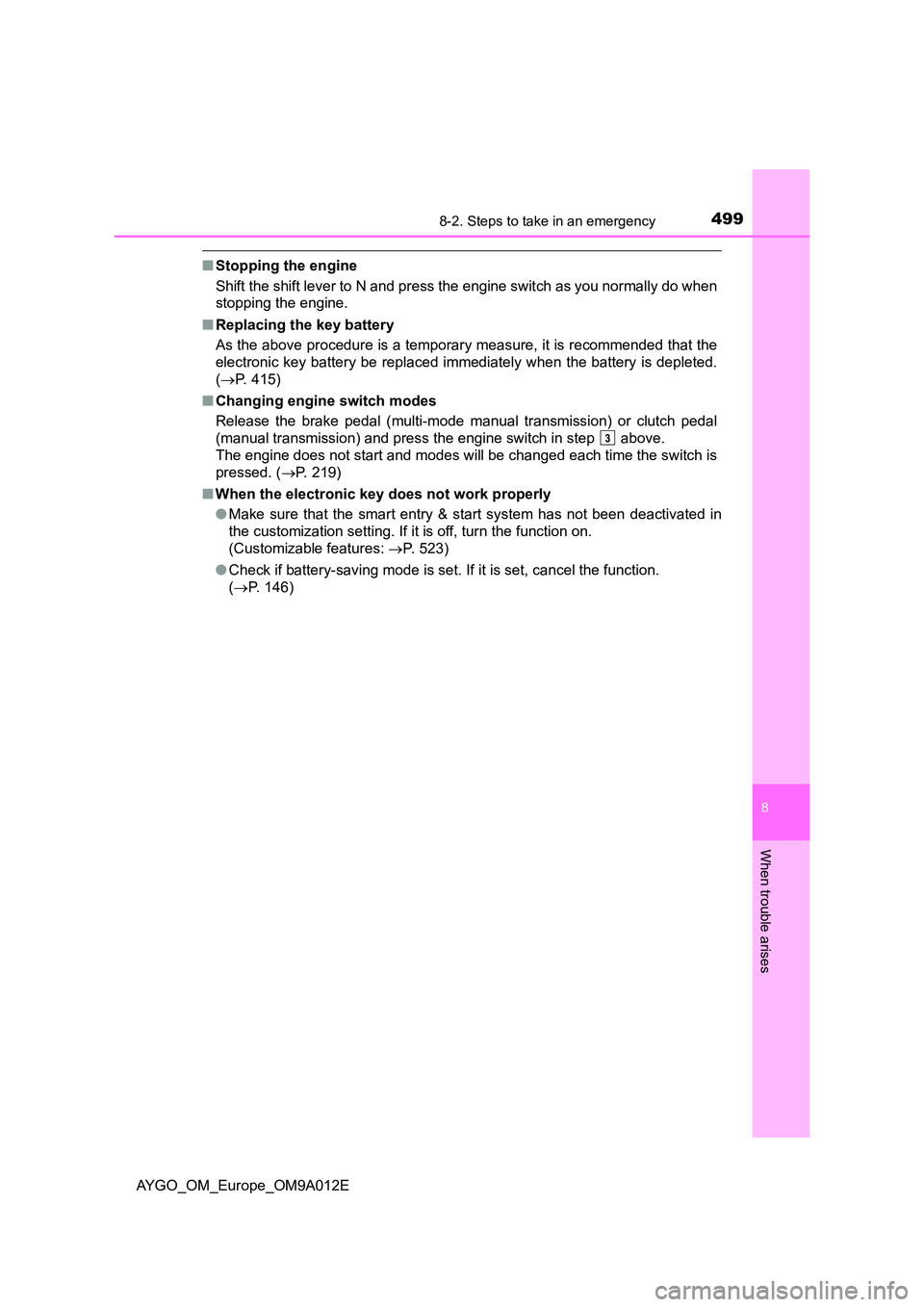
4998-2. Steps to take in an emergency
8
When trouble arises
AYGO_OM_Europe_OM9A012E
■Stopping the engine
Shift the shift lever to N and press the engine switch as you normally do when
stopping the engine.
■ Replacing the key battery
As the above procedure is a temporary measure, it is recommended that the
electronic key battery be replaced immediately when the battery is depleted.
( P. 415)
■ Changing engine switch modes
Release the brake pedal (multi-mode m anual transmission) or clutch pedal
(manual transmission) and press t he engine switch in step above.
The engine does not start and modes will be changed each time the switch is
pressed. ( P. 219)
■ When the electronic key does not work properly
● Make sure that the smart entry & start system has not been deactivated in
the customization setting. If it is off, turn the function on.
(Customizable features: P. 523)
● Check if battery-saving mode is set. If it is set, cancel the function.
( P. 146)
Page 502 of 546
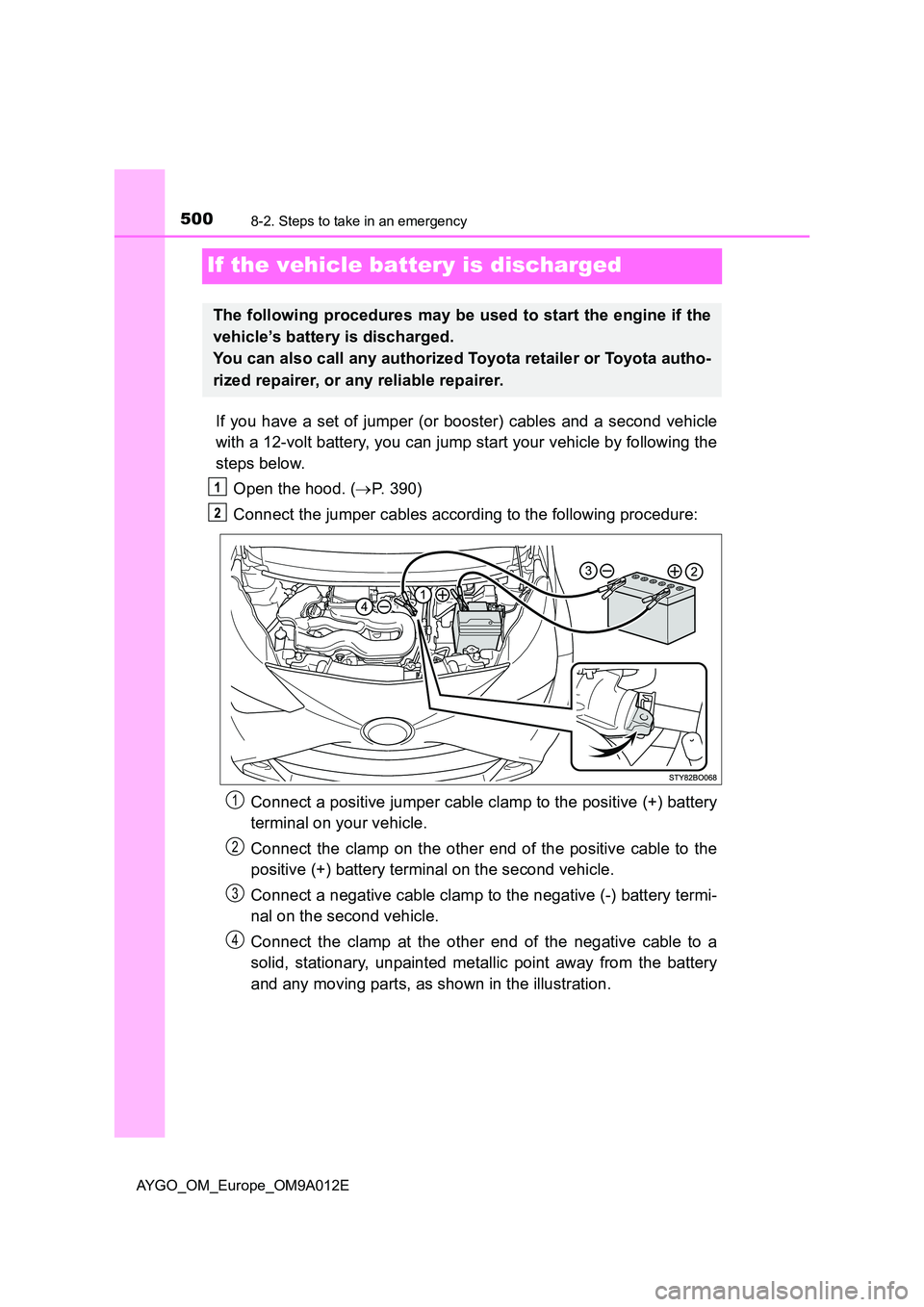
5008-2. Steps to take in an emergency
AYGO_OM_Europe_OM9A012E
If the vehicle battery is discharged
If you have a set of jumper (or booster) cables and a second vehicle
with a 12-volt battery, you can jump start your vehicle by following the
steps below.
Open the hood. ( P. 390)
Connect the jumper cables according to the following procedure:
Connect a positive jumper cable clamp to the positive (+) battery
terminal on your vehicle.
Connect the clamp on the other end of the positive cable to the
positive (+) battery terminal on the second vehicle.
Connect a negative cable clamp to the negative (-) battery termi-
nal on the second vehicle.
Connect the clamp at the other end of the negative cable to a
solid, stationary, unpainted metallic point away from the battery
and any moving parts, as shown in the illustration.
The following procedures may be used to start the engine if the
vehicle’s battery is discharged.
You can also call any authorized Toyota retailer or Toyota autho-
rized repairer, or any reliable repairer.
1
2
3
4
Page 503 of 546
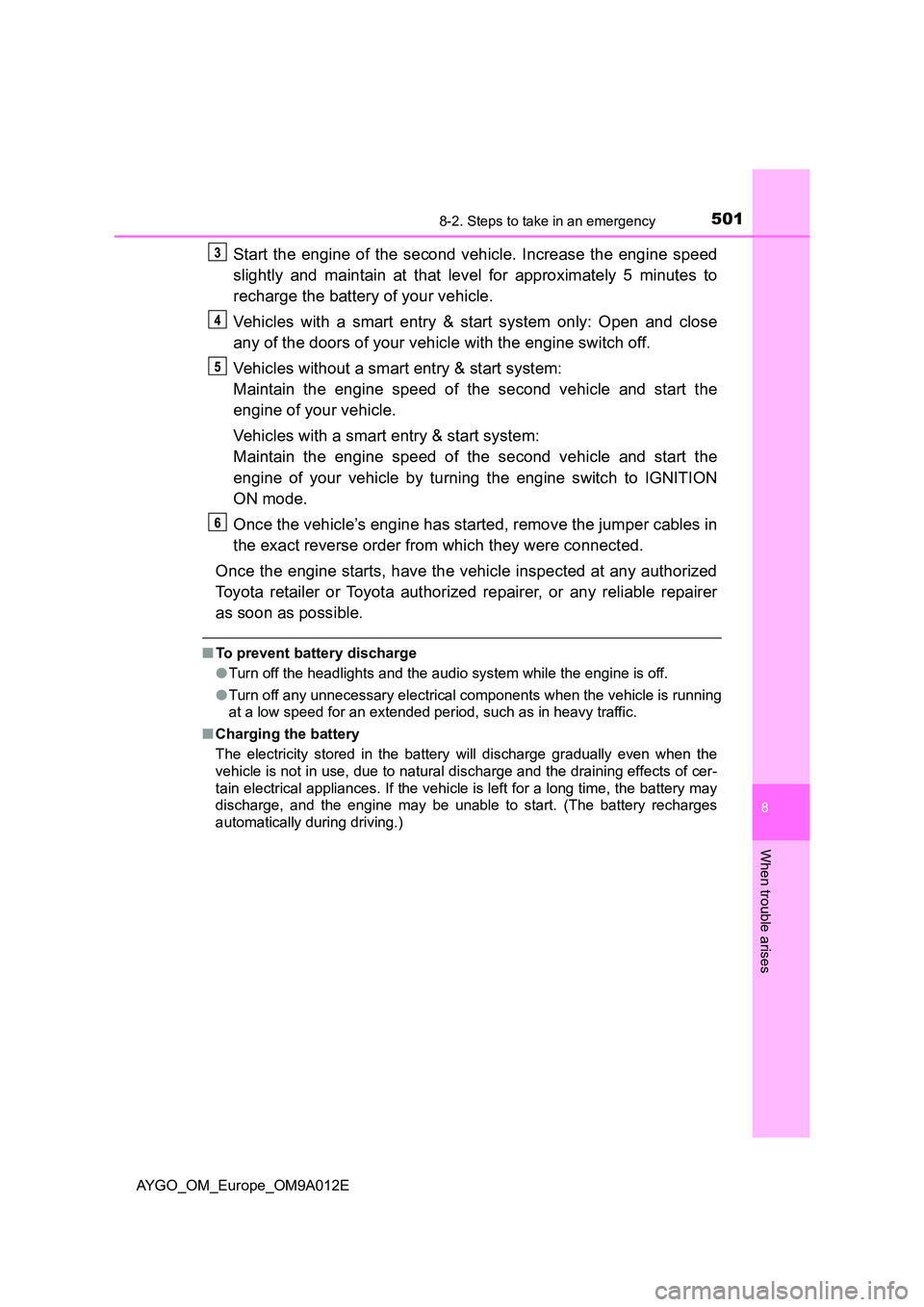
5018-2. Steps to take in an emergency
8
When trouble arises
AYGO_OM_Europe_OM9A012E
Start the engine of the second vehicle. Increase the engine speed
slightly and maintain at that level for approximately 5 minutes to
recharge the battery of your vehicle.
Vehicles with a smart entry & start system only: Open and close
any of the doors of your vehicle with the engine switch off.
Vehicles without a smart entry & start system:
Maintain the engine speed of the second vehicle and start the
engine of your vehicle.
Vehicles with a smart entry & start system:
Maintain the engine speed of the second vehicle and start the
engine of your vehicle by turning the engine switch to IGNITION
ON mode.
Once the vehicle’s engine has started, remove the jumper cables in
the exact reverse order from which they were connected.
Once the engine starts, have the vehicle inspected at any authorized
Toyota retailer or Toyota authorized repairer, or any reliable repairer
as soon as possible.
■ To prevent battery discharge
● Turn off the headlights and the audio system while the engine is off.
● Turn off any unnecessary electrical components when the vehicle is running
at a low speed for an extended period, such as in heavy traffic.
■ Charging the battery
The electricity stored in the battery will discharge gradually even when the
vehicle is not in use, due to natural discharge and the draining effects of cer-
tain electrical appliances. If the vehicle is left for a long time, the battery may
discharge, and the engine may be unable to start. (The battery recharges
automatically during driving.)
Page 504 of 546

5028-2. Steps to take in an emergency
AYGO_OM_Europe_OM9A012E
■ Precautions when the battery is discharged (vehicles with a smart entry
& start system)
● In some cases, it may not be possible to unlock the doors using the smart
entry & start system when the battery is discharged. Use the wireless
remote control or the mechanical key to lock or unlock the doors.
● The engine may not start on the first attempt after the battery has recharged
but will start normally after the second attempt. This is not a malfunction.
● The engine switch mode is memorized by the vehicle. When the battery is
reconnected, the system will return to the mode it was in before the battery
was discharged. Before disconnecting the battery, turn the engine switch off.
If you are unsure what mode the engine switch was in before the battery dis-
charged, be especially careful when reconnecting the battery.
■ When replacing the battery
● Use a battery that conforms to European regulations.
● Use a battery with the same case size as the previous one;
vehicles without cold area specifications or a stop & start system: (LN0),
20 hours rate capacity (20HR) is equiva lent (35Ah) or greater, and perfor-
mance rating (CCA) is equivalent (300A) or greater;
vehicles with cold area specifications: (LN0), 20 hours rate capacity (20HR)
is equivalent (42Ah) or greater, and performance rating (CCA) is equivalent
(390A) or greater; or
vehicles with a stop & start system: (LN2), 20 hours rate capacity (20HR) is
equivalent (60Ah) or greater, and performance rating (CCA) is equivalent
(540A) or greater.
• If the sizes differ, the battery cannot be properly secured.
• If the 20 hour rate capacity is low, even if the time period where the vehi-
cle is not used is a short time, the battery may discharge and the engine
may not be able to start.
● For details, consult any authorized Toyota retailer or Toyota authorized
repairer, or any reliable repairer.
Page 505 of 546
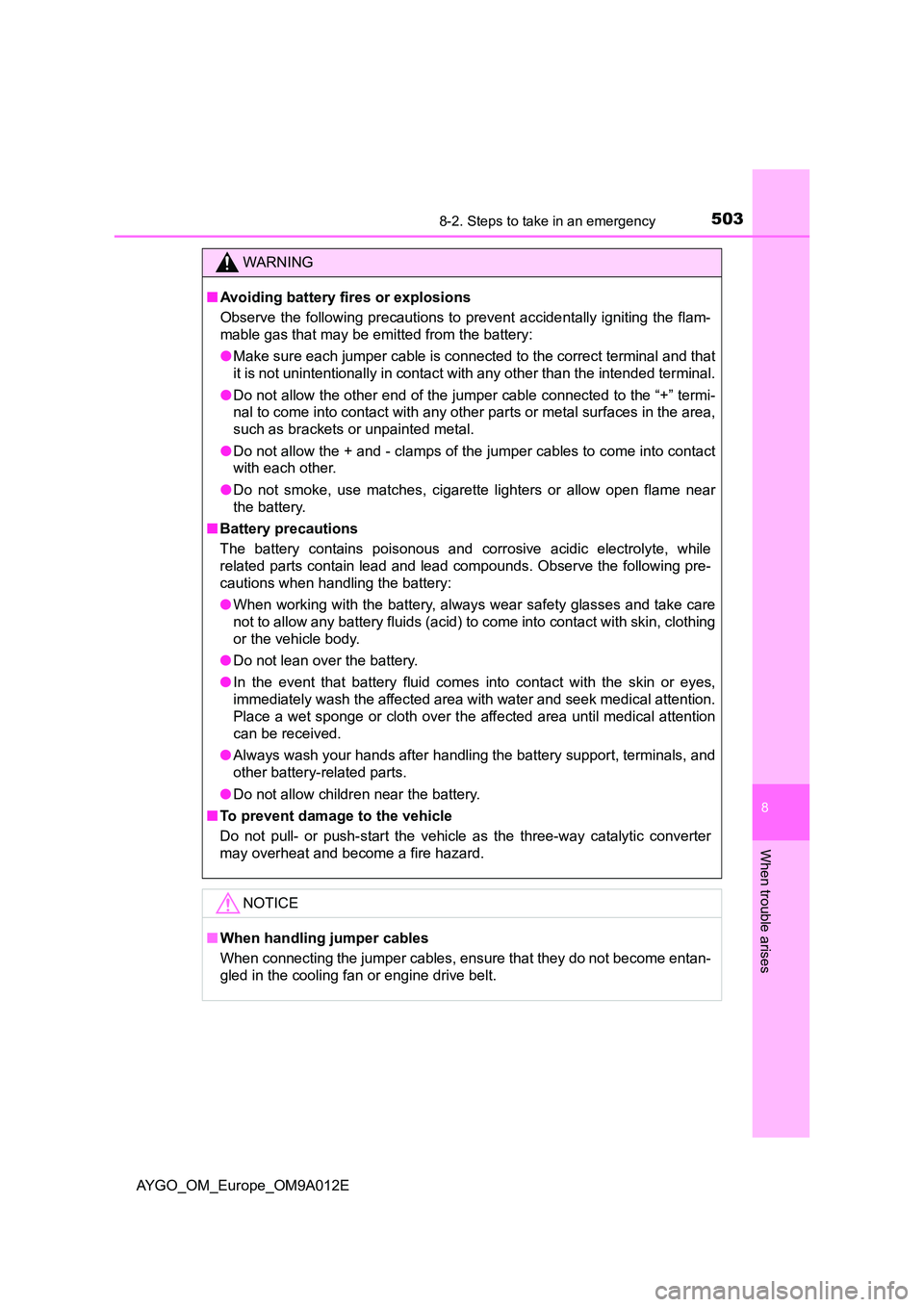
5038-2. Steps to take in an emergency
8
When trouble arises
AYGO_OM_Europe_OM9A012E
WARNING
■Avoiding battery fires or explosions
Observe the following precautions to prevent accidentally igniting the flam-
mable gas that may be emitted from the battery:
● Make sure each jumper cable is connected to the correct terminal and that
it is not unintentionally in contact with any other than the intended terminal.
● Do not allow the other end of the jumper cable connected to the “+” termi-
nal to come into contact with any other parts or metal surfaces in the area,
such as brackets or unpainted metal.
● Do not allow the + and - clamps of the jumper cables to come into contact
with each other.
● Do not smoke, use matches, cigarette lighters or allow open flame near
the battery.
■ Battery precautions
The battery contains poisonous and corrosive acidic electrolyte, while
related parts contain lead and lead compounds. Observe the following pre-
cautions when handling the battery:
● When working with the battery, always wear safety glasses and take care
not to allow any battery fluids (acid) to come into contact with skin, clothing
or the vehicle body.
● Do not lean over the battery.
● In the event that battery fluid comes into contact with the skin or eyes,
immediately wash the affected area with water and seek medical attention.
Place a wet sponge or cloth over the affected area until medical attention
can be received.
● Always wash your hands after handling the battery support, terminals, and
other battery-related parts.
● Do not allow children near the battery.
■ To prevent damage to the vehicle
Do not pull- or push-start the vehicle as the three-way catalytic converter
may overheat and become a fire hazard.
NOTICE
■ When handling jumper cables
When connecting the jumper cables, ensure that they do not become entan-
gled in the cooling fan or engine drive belt.
Page 506 of 546
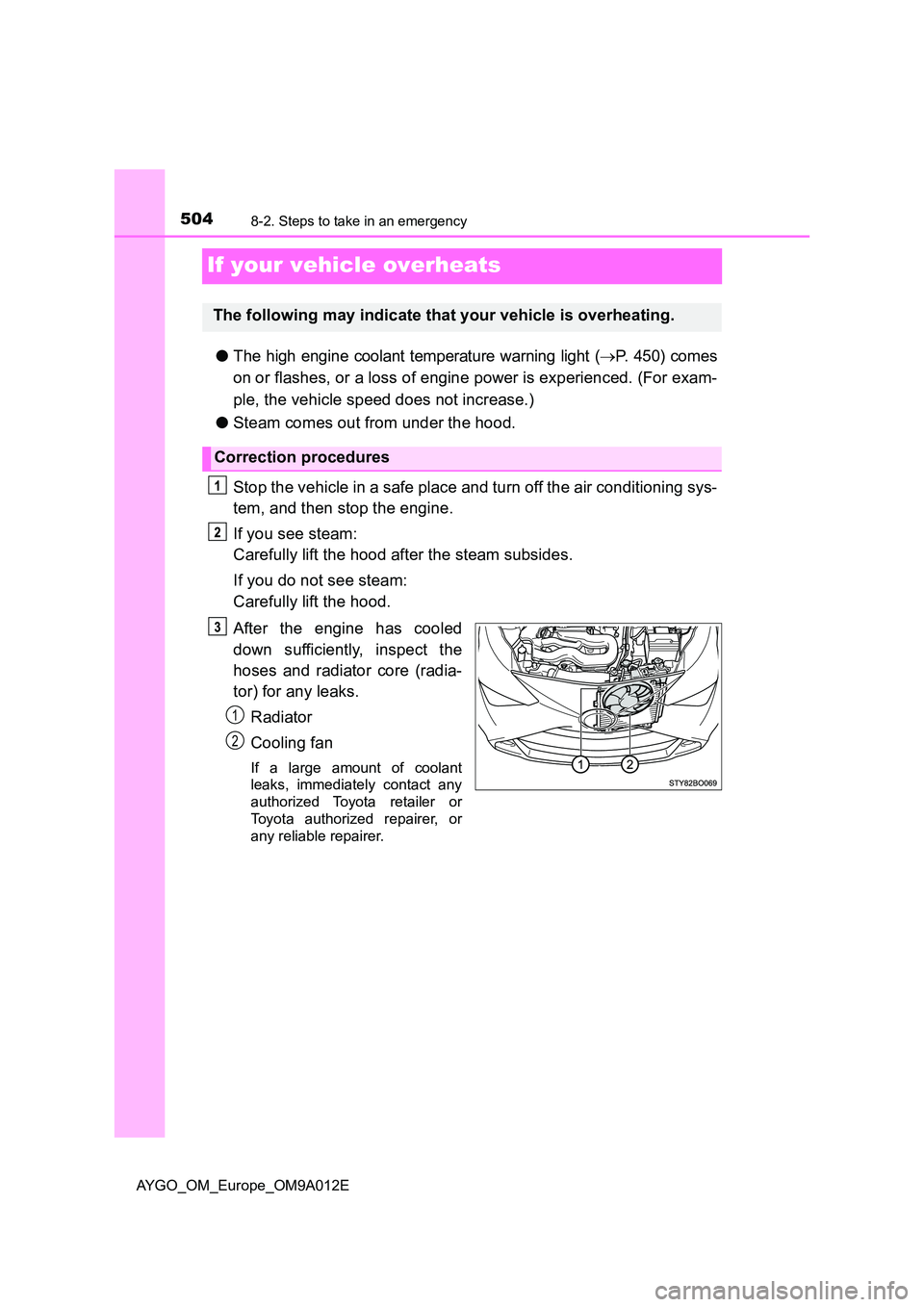
5048-2. Steps to take in an emergency
AYGO_OM_Europe_OM9A012E
If your vehicle overheats
●The high engine coolant temperature warning light (P. 450) comes
on or flashes, or a loss of engine power is experienced. (For exam-
ple, the vehicle speed does not increase.)
● Steam comes out from under the hood.
Stop the vehicle in a safe place and turn off the air conditioning sys-
tem, and then stop the engine.
If you see steam:
Carefully lift the hood after the steam subsides.
If you do not see steam:
Carefully lift the hood.
After the engine has cooled
down sufficiently, inspect the
hoses and radiator core (radia-
tor) for any leaks.
Radiator
Cooling fan
If a large amount of coolant
leaks, immediately contact any
authorized Toyota retailer or
Toyota authorized repairer, or
any reliable repairer.
The following may indicate that your vehicle is overheating.
Correction procedures
1
2
Page 507 of 546

5058-2. Steps to take in an emergency
8
When trouble arises
AYGO_OM_Europe_OM9A012E
The coolant level is satisfactory if it is between the “FULL” or “F”
and “LOW” lines on the reservoir.
Radiator cap
Reservoir
“FULL” or “F”
“LOW”
Add coolant if necessary.
Water can be used in an emer-
gency if coolant is unavailable.
Start the engine and turn the air conditioning system on to check
that the radiator cooling fan operate and to check for coolant leaks
from the radiator or hoses.
The fan operate when the air conditioning system is turned on immediately
after a cold start. Confirm that the fan is operating by checking the fan
sound and air flow. If it is difficult to check these, turn the air conditioning
system on and off repeatedly. (The fan may not operate in freezing tem-
peratures.)
Ty pe ATy pe B
1
2
3
4
Page 508 of 546
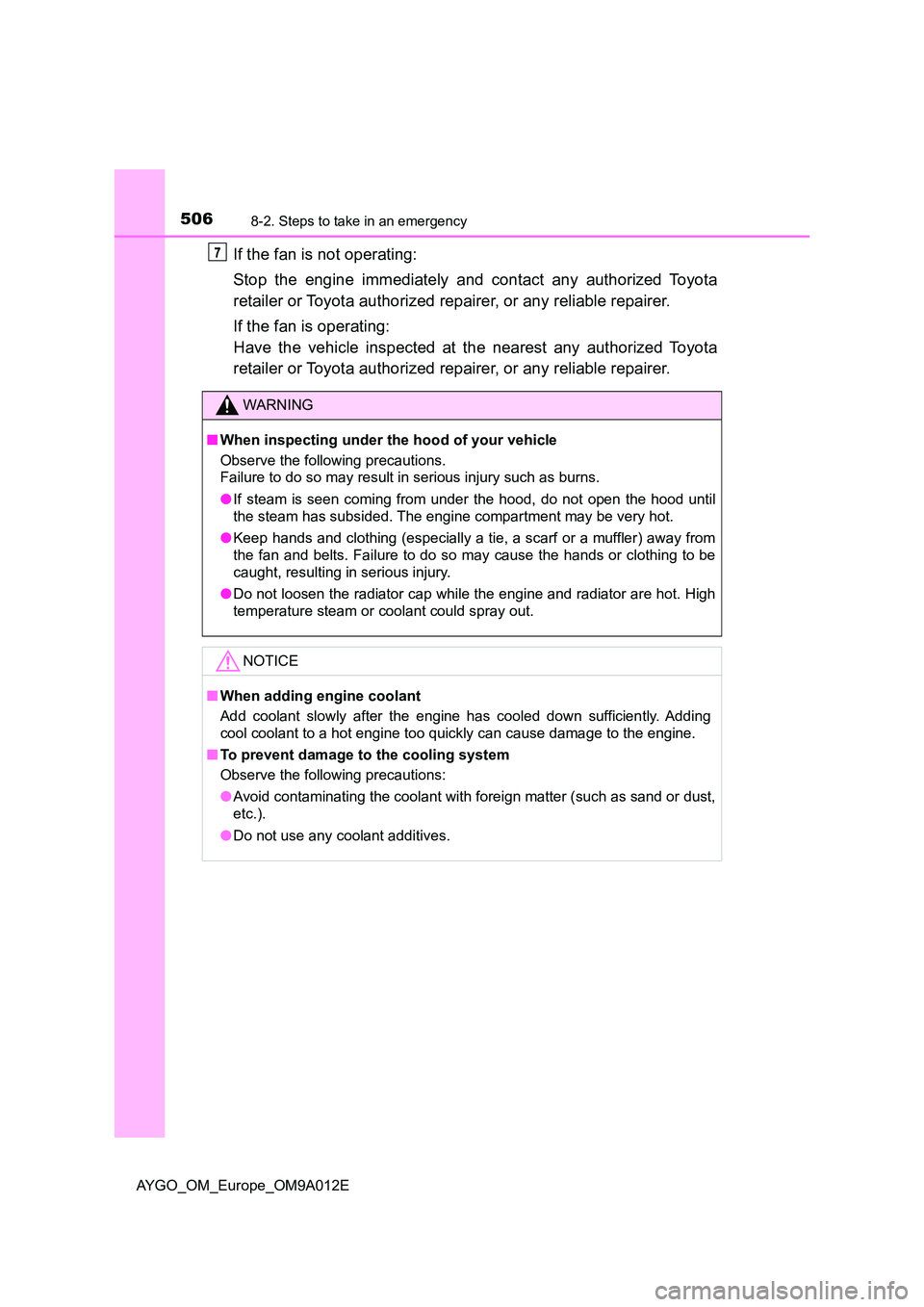
5068-2. Steps to take in an emergency
AYGO_OM_Europe_OM9A012E
If the fan is not operating:
Stop the engine immediately and contact any authorized Toyota
retailer or Toyota authorized repairer, or any reliable repairer.
If the fan is operating:
Have the vehicle inspected at the nearest any authorized Toyota
retailer or Toyota authorized repairer, or any reliable repairer.
WARNING
■ When inspecting under the hood of your vehicle
Observe the following precautions.
Failure to do so may result in serious injury such as burns.
● If steam is seen coming from under the hood, do not open the hood until
the steam has subsided. The engine compartment may be very hot.
● Keep hands and clothing (especially a tie, a scarf or a muffler) away from
the fan and belts. Failure to do so may cause the hands or clothing to be
caught, resulting in serious injury.
● Do not loosen the radiator cap while the engine and radiator are hot. High
temperature steam or coolant could spray out.
NOTICE
■ When adding engine coolant
Add coolant slowly after the engine has cooled down sufficiently. Adding
cool coolant to a hot engine too quickly can cause damage to the engine.
■ To prevent damage to the cooling system
Observe the following precautions:
● Avoid contaminating the coolant with foreign matter (such as sand or dust,
etc.).
● Do not use any coolant additives.
Page 509 of 546

5078-2. Steps to take in an emergency
8
When trouble arises
AYGO_OM_Europe_OM9A012E
If the vehicle becomes stuck
Stop the engine. Set the parking brake and shift the shift lever to N.
Remove the mud, snow or sand from around the stuck tire.
Place wood, stones or some other material to help provide traction
under the tires.
Restart the engine.
Shift the shift lever to E, M or R (multi-mode manual transmission)
or 1 or R (manual transmission) and release the parking brake.
Then, while exercising caution, depress the accelerator pedal.
■ When it is difficult to free the vehicle
Press to turn off TRC.
Turn off TRC and/or VSC if these functions are hampering your attempts to
free the vehicle. ( P. 280)
■ Emergency hooks
Carry out the following procedures if the tires spin or the vehicle
becomes stuck in mud, dirt or snow:
When your vehicle becomes stuck and
cannot move, the emergency hooks are
used for another vehicle to pull your
vehicle to pull your vehicle out in an
emergency.
Your vehicle is not designed to tow
another vehicle.
Page 510 of 546

5088-2. Steps to take in an emergency
AYGO_OM_Europe_OM9A012E
WARNING
■When attempting to free a stuck vehicle
If you choose to push the vehicle back and forth to free it, make sure the
surrounding area is clear to avoid striking other vehicles, objects or people.
The vehicle may also lunge forward or lunge back suddenly as it becomes
free. Use extreme caution.
■ When shifting the shift lever (vehicles with a multi-mode manual trans-
mission)
Be careful not to shift the shift lever with the accelerator pedal depressed.
This may lead to unexpected rapid acceleration of the vehicle that may
cause an accident resulting in death or serious injury.
NOTICE
■ To avoid damaging the transmission and other components
● Avoid spinning the wheels and depressing the accelerator pedal more
than necessary.
● If the vehicle remains stuck even after these procedures are performed,
the vehicle may require towing to be freed.